If you’re considering Growth Hacking as a new way of working for your marketing or growth team, you’ll need a clear process to follow, because growth hacking is not magic.
In this post, I’ll explain what the G.R.O.W.S.-process by Growth Tribe is and explain how to run your growth experiments step-by-step with examples for every step.
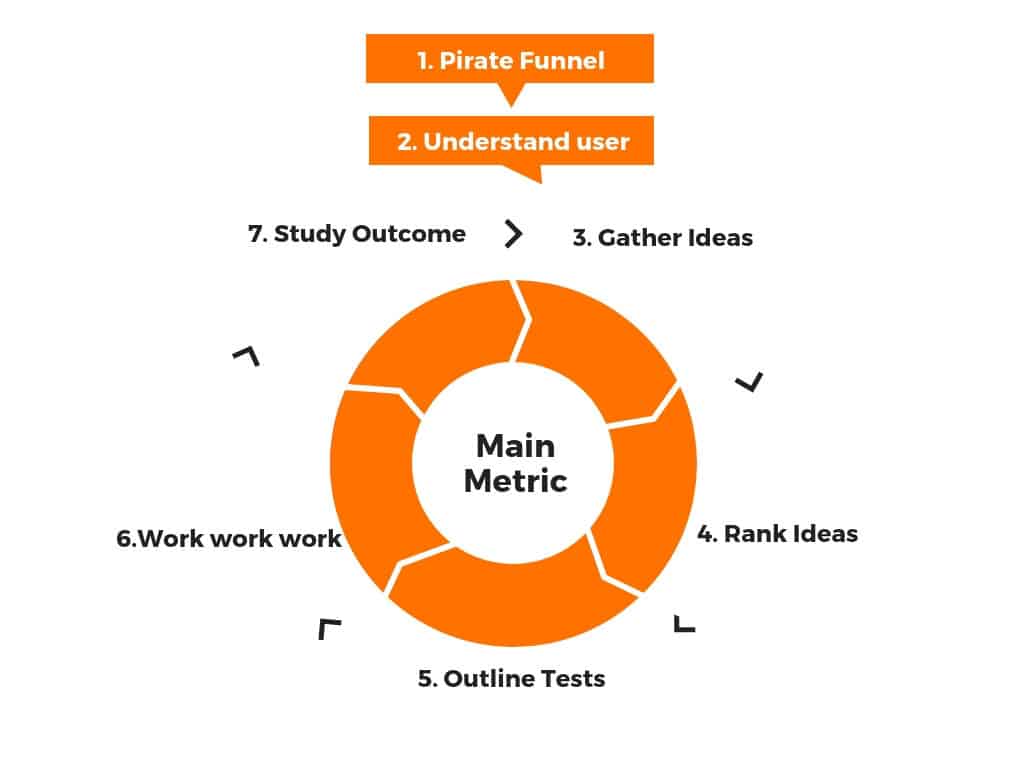
What is the G.R.O.W.S.-process?
The G.R.O.W.S.-process is a 5-step loop for growth hackers to run experiments. It has been developed by Growth Tribe in 2016 to help growth hacking teams implement a process-based way of working. These are the five steps of the G.R.O.W.S. framework:
- G – Gather Ideas: Brainstorm as many experiment-ideas as possible with your team.
- R – Rank Ideas: Use the BRASS or PIE-framework to prioritize which ideas have the highest ROI (=potential x effort).
- O – Outline Experiments: Choose your next steps and design your experiment as quick and small as possible.
- W – Work work work: Execute your experiment in a 2-4 week window.
- S – Study (and Implement) outcome: Analyze the data from your experiment and decide on the next steps to take: learn or implement!
Note: You will need this before you can start the GROWS-process!
It is important to know how to use the G.R.O.W.S. process: for growth or for confirming your Product / Market fit?
If your company has not yet found a Product / Market-Fit, you should use this experiment cycle to get to know your customer better and to better tailor your product to them.
Once you have found Product / Market-fit, then you start looking for better channels to really grow.
I also recommend that you make a good overview of your business and your client before you start. Have the following canvases or numbers ready for your own focus:
- Business Model Canvas to map your business;
- Value Proposition Canvas & Scanvas, to work based on your client’s needs, and the;
- Pirate Funnel, to determine which part of your customer journey gets the most attention needs (also known as your One Metric That Matters / OMTM).
The 5 steps of the G.R.O.W.S.-process from Growth Tribe:
The GROWS process consists of 5 steps: Brainstorming ideas for growth, prioritize those ideas, make a plan for your best idea, execute that plan and analyze the outcome of your ideas.
There are a lot of alternatives to Growth Tribe’s GROWS process, such as Brian Balfour’s growth machine or the Neil Patel steps, but in practice, they all come down to the same thing and are just nuances.
Let’s have a look at the steps of the G.R.O.W.S. process:
Gather Ideas (G of G.R.O.W.S.)
If all goes well, you have discovered through data and customer surveys what the biggest problem is that’s preventing customer growth (if not, follow my instructions in my Pirate Funnel-article). That will be our OMTM (One Metric That Matters) and this is the problem we want to tackle next!
We start by brainstorming a list of experiment ideas for possible solutions. This can be anything and there’s no good or bad in this step, but quantity is the most important. You call this list of ideas your ‘backlog’.
For example, you can come up with new experiments in the following ways:
- Look for complaints that your customer service has received
- Do live user testing to hear what is holding back your customers
- See how competitors approach this part of the funnel on their website
- Read case studies online from competitors or companies from other industries
- Brainstorm with a diverse group of employees
- Interview dropouts from your funnel or loyal customers
- View Hotjar-recordings or heatmaps
Rank Ideas (R of G.R.O.W.S.)
By now, you should have a long list of experiment ideas, but we don’t have time to do all those experiments. That is why we want to prioritize them and we want to start with the idea that has the greatest chance of success and, relatively speaking, takes the least effort.
You can choose from a few different frameworks:
- B.R.A.S.S.-framework, if you want to test acquisition channels (developed by Growth Tribe), which stands for the criteria Blink, Relevance, Availability, Scalability and Score.
- Or the P.I.E.- or I.C.E.-framework, suitable for experiments around conversion optimization, retention or referral. Which stand for Potential, Importance and Ease, and Impact, Confidence and Effort. These options are fairly the same.
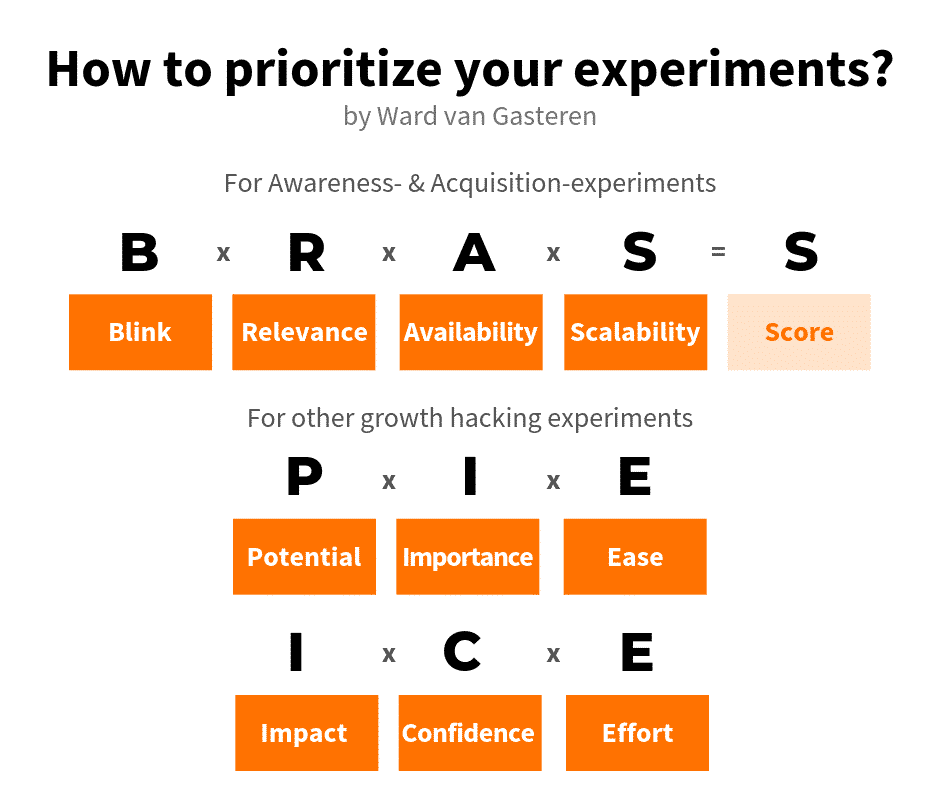
Or you can make your own combination of different criteria that are important in your situation. The above frameworks make a trade-off between input (how much money/time/effort do you put in) and output (how much money/conversion increase does it yield), combined with the chance of success.
Depending on your situation, you may want to make one metric slightly more important than the other metric. For example, if you have a lot of funding and manpower, then Ease, Effort or Scalability are less important.
The idea with the highest score is the idea that you want to perform first. If this experiment fails, then you want to proceed to the next experiment on the list with the second highest score.
Outline Experiments (O of G.R.O.W.S.)
As growth hackers, we want to work efficiently and that is why it’s useful to think carefully about the structure of our experiment beforehand. Otherwise, it can cost a lot of effort.
Write out in advance how you want to test the idea in the form of an experiment. Here I have a full article on how to plan & keep track of your growth experiments. Take the following factors into account:
- How long should the experiment last? If you want the experiment to yield significance, you can calculate in advance how much traffic you need and therefore how much time you need. You’ll need at least 2 weeks, but at the same time, you also don’t want to run an AB test for longer than 30 days, as expired cookies could cause problems with your tracking.
- Is it technologically possible? Do you have the right growth hacking tools to get started? For example, have a look at AB-testing software with the right features like multi-page testing or look if your CRM system can produce the right data.
- Which stakeholders should you involve? You probably need to inform the marketing and sales team, so that they can take the possible extra traffic or a slightly different website into account. And you don’t want to get into a fight with IT when you’re making adjustments in the same place at the same time.
- What skills do you need within your team? Do you have to involve a developer? Or do you need time from the design department, then it is useful to arrange this in advance.
- What do you have to track? Nothing is as bad as discovering afterwards that an experiment was useless, because you didn’t measure properly what you needed to know. You may also want to measure intermediate steps, in case your KPI is a ‘doubt’-case, or you want to collect additional details because stakeholders may be asking questions about this.
- When is the experiment successful? It is wise to determine this in advance. Then you have a more objective view of the experiment and you are better off sticking.
- How much time will it take to kickstart the experiment? Or rather, how can you ensure that it takes as little time as possible? Personally, I say that you should not spend more than 2 business days setting up the experiment. If you think you need more time, you’re probably thinking too big and you’re already going to waste time and effort.
Work work work (W of G.R.O.W.S.)
This is a fairly clear step. A few extra pieces of advice:
- Try to sit together with your entire team while setting up the experiment. Then you can get more done quicker and communication goes a lot faster.
- Create a scrum board (with the columns ‘ to do ‘, ‘ doing ‘ and ‘ done ‘) with assigned tasks. This way you have a clear overview of what still needs to be done and who is working on what.
Study Outcome (S of G.R.O.W.S.)
This is the most important step of all! Check whether you have collected enough data to be able to draw conclusions.
Try to translate the data into concrete insights that the rest of the company can take with them into their daily tasks. It helps to formulate the insights in visual form (examples, graphs or video) instead of percentages. Other people might be less data-savvy than you might think.
With regard to stakeholders and management, it can also be very useful to communicate in terms of financial improvement or potential.
If you get new ideas to test based on your results, you can add these ideas to your backlog. Then the G.R.O.W.S. cycle starts again from the beginning.
Keep repeating this process
Prepare yourself that you probably won’t find a (major) improvement the first few times.
For beginning growth hackers, a success rate of 1 in 10 experiments is common. Experienced growth hackers can lower this to around 1 in 3 experiments. If there was one success-formula, everyone would use it.
FAQ about G.R.O.W.S. process
TLDR; Here are some quick answers to your burning questions.
What is the GROWS process?
The GROWS process is a 5-step cycle for growth hackers to set up experiments. It was developed by Growth Tribe in 2015 as a process to follow for growth hacking teams. The five steps of the GROWS process are: Gather Ideas, Rank Ideas, Outline Experiment, Work and Study Outcome.
It is advisable to analyze your business step-by-step to find its weak spots the Business Model Canvas, Value Proposition Canvas and the Pirate Funnel so that you can work with focus. In this blog, I’ll explain how you should use these resources.
For beginning growth hackers, a success rate of 1 in 10 experiments is common. Experienced growth hackers can reduce this to around 1 in 3 experiments.
For steps G, R and O you need about 1 to 2 days, then 2 more days for the W (setting up the experiment) and finally let the experiment run for about 1 to 4 weeks before you start analyzing. In total, one cycle could take 1,5 to 5 weeks from start to finish.
Ready to get started?
If there is anything unclear about the G.R.O.W.S.-process, if you need my help or if you want to add something to this blog, you can send an email to ward@growwithward.com.



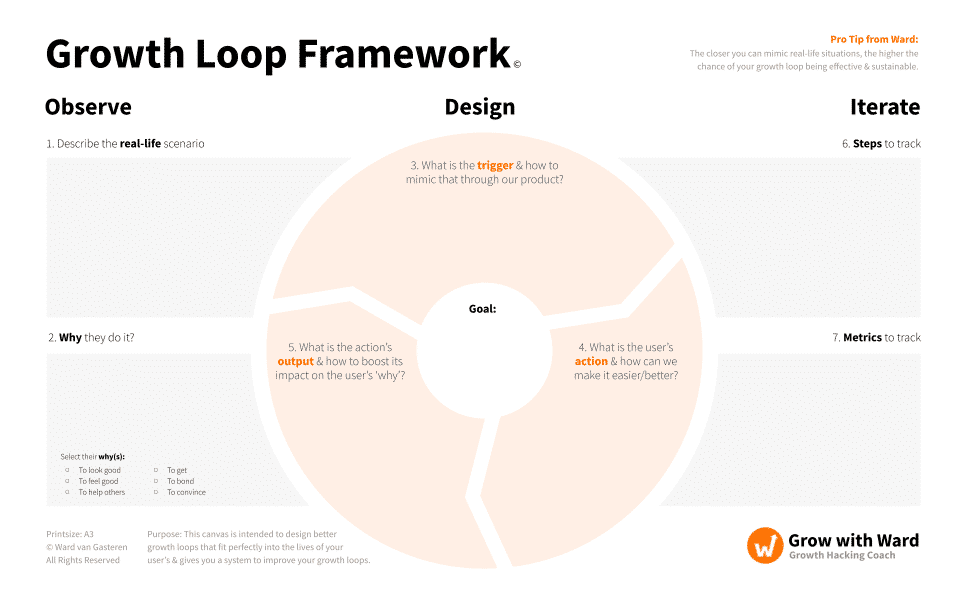
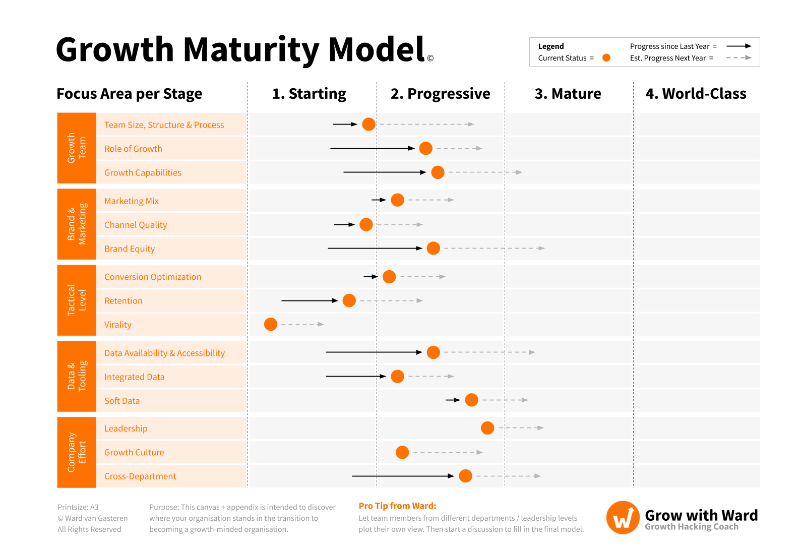
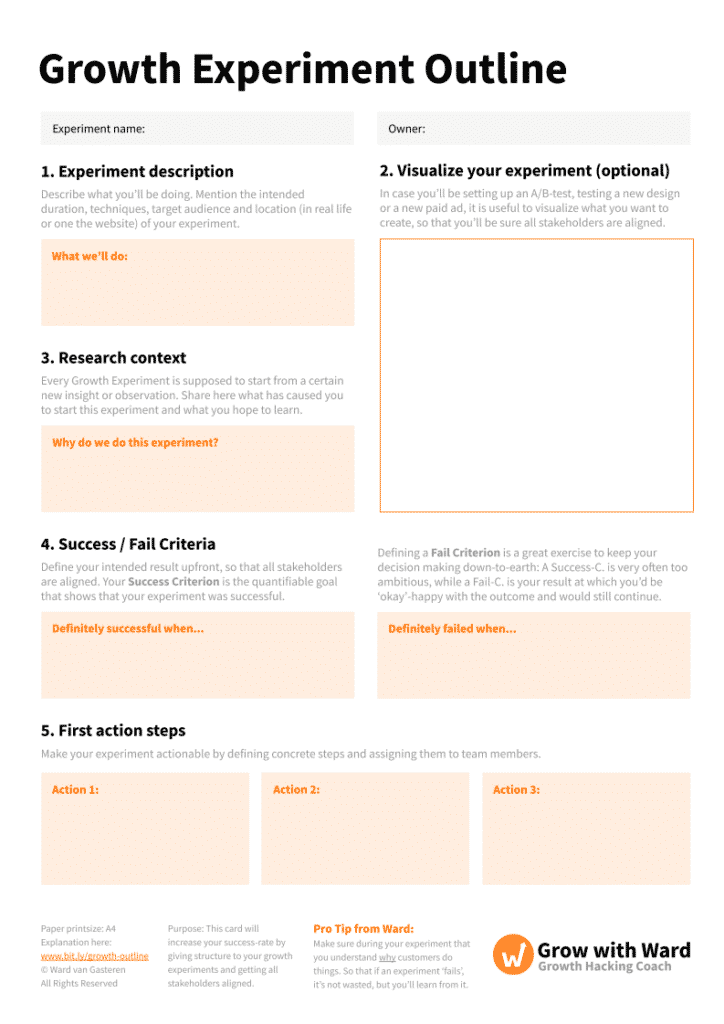
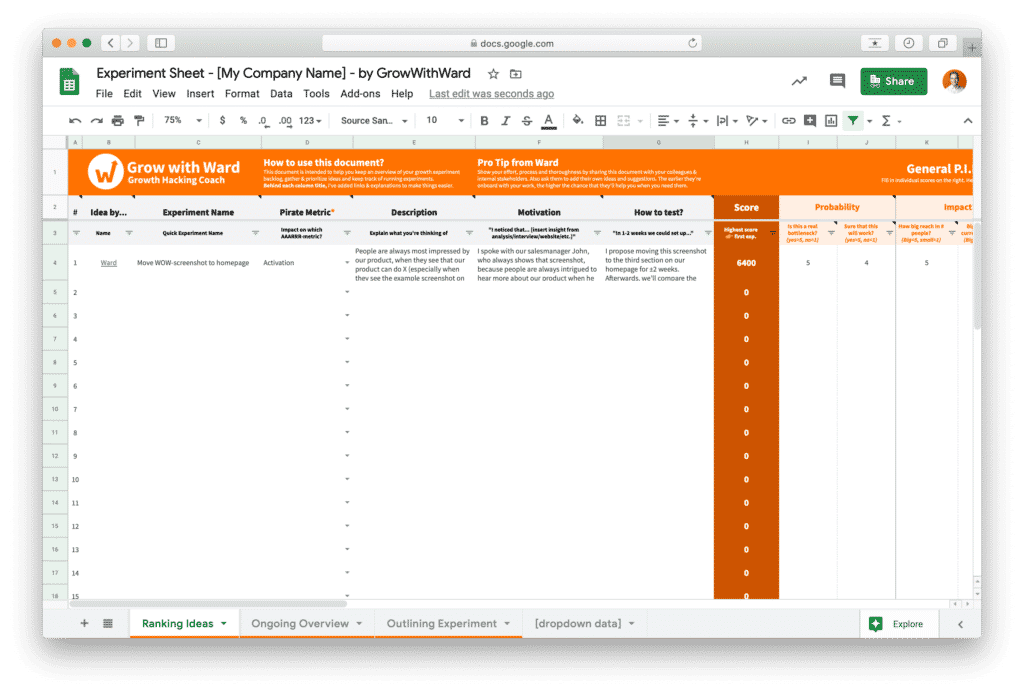

6 thoughts on “G.R.O.W.S.-process, a step-by-step growth hacking process (by Growth Tribe)”
Great article
Thanks Kullah! Happy to help
Question: I am trying to apply the B.R.A.S.S. template.
Does one just average up the scores from a team?
So, if 7 people, does each person score and idea and then the average of the scores is taken?
Thanks in advance,
K.Anderson
^ …score AN idea…
Hi Kullah! Good question: I take the average score per criteria and multiply those with each other to get the last S of BRASS. Feel free to play around with the weight of each criteria: depending on the context you might want to put more emphasis on one thing and less on the other. That way your total score is calculated like (2xB) x R x (0,5xA) x S = S. Same goes for PIE and ICE prioritization.
Extra tip: Overall this doesn’t give any problems, but keep your eyes open for big differences in score between team members: this is a red flag that the experiment isn’t clear or that you need more research to understand the value.